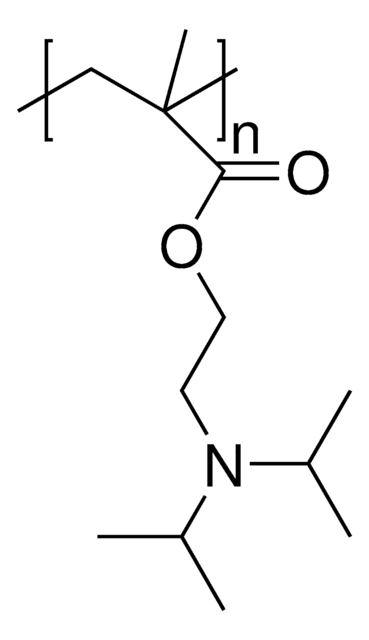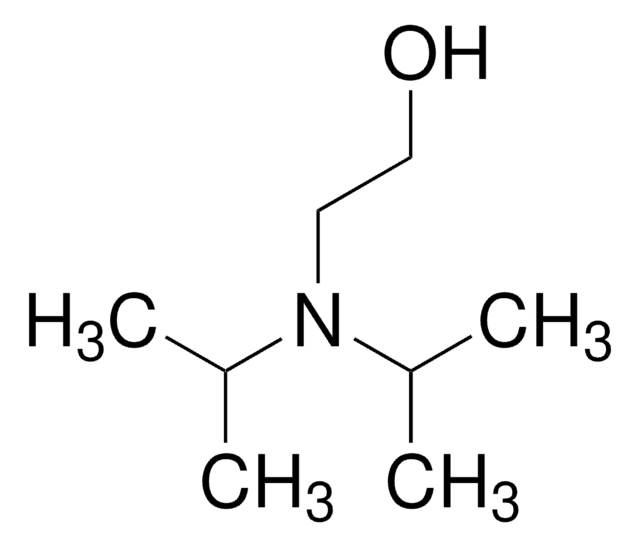Alle Fotos(2)
Wichtige Dokumente
730971
2-(Diisopropylamino)ethylmethacrylat
97%, contains ~100 ppm monomethyl ether hydroquinone as inhibitor
Synonym(e):
DPA, DPAEMA
Anmeldenzur Ansicht organisationsspezifischer und vertraglich vereinbarter Preise
Alle Fotos(2)
About This Item
Empirische Formel (Hill-System):
C12H23NO2
CAS-Nummer:
Molekulargewicht:
213.32
EG-Nummer:
MDL-Nummer:
UNSPSC-Code:
12162002
PubChem Substanz-ID:
NACRES:
NA.23
Empfohlene Produkte
Qualitätsniveau
Assay
97%
Form
liquid
Enthält
~100 ppm monomethyl ether hydroquinone as inhibitor
Brechungsindex
n20/D 1.145
Dichte
0.900 g/mL at 25 °C
Lagertemp.
2-8°C
SMILES String
CC(C)N(CCOC(=O)C(C)=C)C(C)C
InChI
1S/C12H23NO2/c1-9(2)12(14)15-8-7-13(10(3)4)11(5)6/h10-11H,1,7-8H2,2-6H3
InChIKey
SVYHMICYJHWXIN-UHFFFAOYSA-N
Allgemeine Beschreibung
2-(Diisopropylamino)ethyl methacrylate (DPA) is a methacrylate class of monomer used to prepare various DPA-derived polymers, which includes poly(2-(diisopropylamino)ethyl methacrylate) (PDPA). PDPA is a water-soluble polymer, which exhibits sensitivity to changes in pH and temperature. At pH levels below its pKa value of approximately 6.5, PDPA undergoes a transition from hydrophobic to hydrophilic behavior. This transition is attributed to the protonation of its amino groups. These unique properties of PDPA polymers consequently make them very useful in various applications such as drug delivery, gene delivery, sensors, surfaces, membranes, and chromatography.
Anwendung
2-(Diisopropylamino)ethyl methacrylate can be used:
- As a monomer in the synthesis of multi-responsive hyperbranched copolymers by combining poly(oligo(ethylene glycol)methyl methacrylate) (P(OEGMA)) and 2-(diisopropylamino)ethyl methacrylate (PDIPAEMA) using RAFT polymerization. These polymers find application in drug delivery, gene delivery and tissue engineering.
- A monomers in the synthesis of block copolymer poly(ethyleneglycol)-b-poly(2-(diisopropylamino)ethyl methacrylate) (PEG-b-PDPAEMA). These pH-responsive micelles can be used for enhanced intracellular drug delivery. The DPA monomer contributes to the pH-responsive nature of the copolymers.
Signalwort
Danger
H-Sätze
Gefahreneinstufungen
Eye Dam. 1 - Skin Irrit. 2 - Skin Sens. 1 - STOT SE 3
Zielorgane
Respiratory system
Lagerklassenschlüssel
10 - Combustible liquids
WGK
WGK 3
Flammpunkt (°F)
210.0 °F
Flammpunkt (°C)
98.9 °C
Hier finden Sie alle aktuellen Versionen:
Besitzen Sie dieses Produkt bereits?
In der Dokumentenbibliothek finden Sie die Dokumentation zu den Produkten, die Sie kürzlich erworben haben.
Kunden haben sich ebenfalls angesehen
Francesco Camerlengo et al.
BMC plant biology, 17(1), 248-248 (2017-12-21)
Among wheat gluten proteins, the α-type gliadins are the major responsible for celiac disease, an autoimmune disorder that affects about 1% of the world population. In fact, these proteins contain several toxic and immunogenic epitopes that trigger the onset of
Aaron Ross Flakemore et al.
Meat science, 123, 79-87 (2016-09-20)
This study evaluated omega-3 intramuscular fatty acids in the longissimus thoracis et lumborum of commercially prepared Australian lamb loin chops. Meats, denuded of external fats were cooked by means of conductive dry-heat using a fry grilling hot plate, to a
Katina Handeland et al.
Nutrition journal, 16(1), 64-64 (2017-10-04)
Fatty fish is the dominant dietary source of n-3 LCPUFAs but it also contains other micronutrients considered important for brain development and function. To our knowledge, the effect of fatty fish intake on cognitive function in adolescents has not been
Laurent Maïmoun et al.
Clinical physiology and functional imaging, 39(5), 345-354 (2019-05-16)
Dual-energy X-ray absorptiometry (DXA) is used in clinical routine to determine areal bone mineral density (aBMD). However, it is not clear whether excessive fat mass or substantial weight loss modify the aBMD measurements. The aim of this study was to
Fernando H Ramírez-Guadiana et al.
PLoS genetics, 13(9), e1007015-e1007015 (2017-09-26)
One of the hallmarks of bacterial endospore formation is the accumulation of high concentrations of pyridine-2,6-dicarboxylic acid (dipicolinic acid or DPA) in the developing spore. This small molecule comprises 5-15% of the dry weight of dormant spores and plays a
Unser Team von Wissenschaftlern verfügt über Erfahrung in allen Forschungsbereichen einschließlich Life Science, Materialwissenschaften, chemischer Synthese, Chromatographie, Analytik und vielen mehr..
Setzen Sie sich mit dem technischen Dienst in Verbindung.


![N-[3-(Dimethylamino)propyl]methacrylamid 99%, contains MEHQ as inhibitor](/deepweb/assets/sigmaaldrich/product/structures/295/145/6b4aae15-7cb5-4b7b-9c06-8e6d24e50951/640/6b4aae15-7cb5-4b7b-9c06-8e6d24e50951.png)




![[2-(Methacryloyloxy)ethyl]trimethylammoniumchlorid -Lösung 75 wt. % in H2O](/deepweb/assets/sigmaaldrich/product/structures/316/612/66b0f4cf-d060-427d-b4f5-e8fab3e5cffe/640/66b0f4cf-d060-427d-b4f5-e8fab3e5cffe.png)







